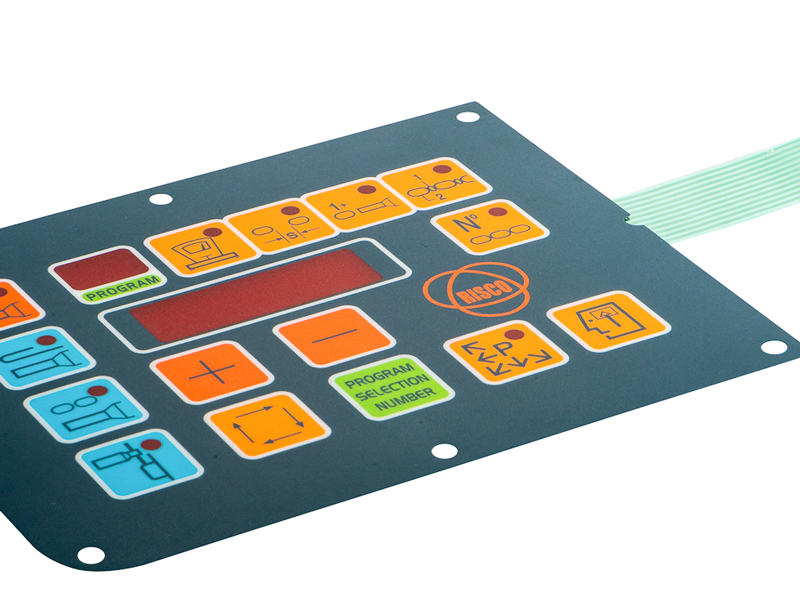Why a Membrane Switch Is Ideal for Industrial and Medical Applications
Wiki Article
Understanding Membrane Layer Switches: The Key to Trusted and long lasting Controls
Membrane switches over stand for an essential facet of modern user interface layout, blending functionality with strength in numerous applications. As we check out the ins and outs of membrane layer buttons, it becomes clear that their role in boosting control systems is both complex and profound, elevating questions concerning exactly how ideal to take advantage of their abilities in future innovations.
What Are Membrane Layer Buttons?
Membrane switches are an advanced service in the world of interface technology, combining capability and layout flawlessly. These gadgets function as a user interface between users and electronic systems, integrating several components into a compact format. Normally built from flexible, thin layers of materials, membrane layer switches are developed to react to touch, allowing individuals to engage with equipment and digital tools successfully.The primary elements of a membrane layer switch include a printed circuit layer, graphic overlay, and a spacer layer that stops unexpected activation. The visuals overlay can be customized to reflect brand name identification or user choices, boosting aesthetic appeals while making sure functionality. Membrane switches are typically utilized in numerous applications, consisting of medical devices, customer electronics, and commercial tools, owing to their toughness and resistance to environmental factors such as wetness and dust.
One of the vital advantages of membrane layer switches is their capacity to stand up to deterioration, making them perfect for high-traffic atmospheres. Additionally, they are light-weight and call for minimal room, permitting ingenious designs in item growth. On the whole, membrane changes stand for a reliable and functional selection for modern-day electronic interfaces, weding technology with user-centric layout principles.
How Membrane Layer Changes Work
The operation of membrane layer changes depend upon a simple yet reliable system that equates individual input into digital signals. These switches contain multiple layers, usually including a graphic overlay, a spacer layer, and a circuit layer. When a user presses the switch, the leading layer warps, permitting a conductive component in the circuit layer to make contact with an equivalent conductive pad on the bottom of the visuals overlay. This contact closes the circuit and sends out an electronic signal to the tool, indicating that the button has actually been turned on.The design of membrane layer switches can vary, but they frequently include domes or tactile elements to supply comments to the customer, improving the overall experience. The materials made use of in membrane buttons, such as polyester or polycarbonate, contribute to their resilience and resistance to ecological factors, consisting of moisture and dirt. Moreover, the published circuits are usually enveloped, which safeguards them from damage over time.

Advantages of Membrane Buttons
One of the primary advantages of membrane layer buttons is their versatility in style, enabling them to be tailored to meet details user needs and visual requirements. This versatility reaches various markets, where various shapes, sizes, and shades can be employed to boost user communication and visual allure.In addition, membrane buttons are understood for their Discover More Here sturdiness. Created from robust products, they are immune to dirt, moisture, and physical wear, which significantly prolongs their life-span contrasted to traditional mechanical switches. This toughness makes them particularly appropriate for high-traffic atmospheres and applications needing long life.

Furthermore, membrane layer buttons provide a structured profile, leading to a thinner style that can be integrated into various devices without including mass. This feature not just improves the visual allure however also adds to a much more ergonomic product layout.

Applications of Membrane Buttons
Easy to use and versatile, membrane buttons find applications across a large range of industries, consisting of medical gadgets, customer electronic devices, and industrial devices. In the clinical area, these switches are essential to gadgets such as diagnostic tools, individual monitoring systems, and mixture pumps, where dependability and simplicity of cleansing are critical. Their ability to maintain and hold up against extreme environments performance makes them suitable important link for such applications.In consumer electronics, membrane layer switches are used in products like microwaves, washing equipments, and push-button controls - membrane switch. Their smooth design enables user-friendly individual interfaces, enhancing the general user experience while offering toughness and resistance to damage
Commercial devices likewise benefits from membrane buttons, specifically in control panels for equipment and automation systems. These switches provide protection versus dirt and wetness, making sure constant performance in challenging settings. Their customizable attributes permit manufacturers to customize them to certain operational requirements, boosting effectiveness and functionality.
Selecting the Right Membrane Layer Switch
When picking a membrane layer switch, it is vital to take into consideration numerous factors that affect efficiency and suitability for details applications. The primary factors to consider include environmental conditions, responsive feedback, longevity, and layout specifications.
First, examine the operating setting; switches exposed to wetness, chemicals, or severe temperature levels require certain products to guarantee durability and functionality. Next off, evaluate the need for responsive comments. Depending on user communication, some applications might take advantage of a responsive action to verify activation, while others might prefer a non-tactile layout for aesthetic reasons.
Resilience is another vital element; membrane buttons need to be created to hold up against regular usage, influences, and abrasion. Ensure the selected button can endure the anticipated lifecycle, particularly in high-usage circumstances.
Verdict
To conclude, membrane layer switches work as vital parts in the layout of reliable and long lasting control systems throughout different industries. Their portable design, combined with durable construction and customizable attributes, boosts individual interaction while ensuring longevity in requiring atmospheres. The versatility of membrane layer changes permits for customized remedies that meet details operational requirements, enhancing their relevance in contemporary technology. membrane switch. As sectors continue to progress, the value of incorporating reliable membrane layer button remedies can not be overemphasized.Membrane changes stand for a critical aspect of modern interface style, mixing performance with resilience in numerous applications.Membrane buttons are an innovative service in the realm of individual interface modern technology, incorporating performance and design flawlessly. Generally constructed from versatile, slim layers of materials, membrane switches are made to respond to touch, allowing customers to interact with machinery and digital tools efficiently.
The layout of membrane layer buttons can vary, but they typically incorporate domes or tactile aspects to supply responses to the customer, informative post enhancing the overall experience.In verdict, membrane layer switches serve as crucial elements in the style of trustworthy and resilient control systems across different markets.
Report this wiki page